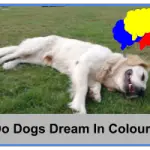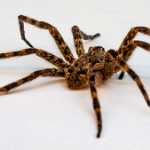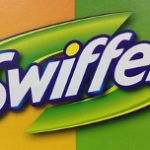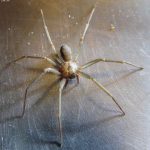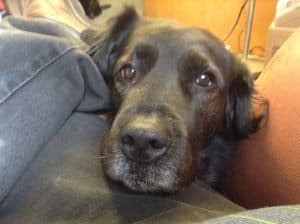
Many pet owners are taken by surprise when they see their dog puffing his cheeks for the first time. What’s that supposed to mean?
A random puffing of the cheeks might not mean anything, but if he does that more often that’s something you need to investigate.
This new habit your dog got might have psychological causes or it might indicate a medical problem.
In this article, we’ll be looking at both possible causes, but we’ll also examine other strange noises dogs make, like reverse sneezing.
Why do dogs puff or huff?
When a dog exhales rapidly this makes his cheeks puff out and it’s often associated with a distinctive sound. Maybe you aren’t even looking at the dog, but you’ll sense that he makes a different breathing sound.
Puffing should not be confused with huffing, which is when the dog is growling or barking at low intensity and puffing his cheeks while he does that.
Stress relief
To understand why your pet is puffing his cheeks, you’ll need to pay attention to the context. In most cases, puffing his cheeks is a way for your dog to relieve stress. One random episode might not be enough to establish the cause, but when he does that repeatedly and a pattern emerges, you can identify what’s making your dog feel anxious.
There can be various situations, like walking down a street where a rival canine lives or maybe it’s the sound of the washing machine that’s bothering him.
If that is the case, you can easily put a stop to the puffing thing by removing the stress trigger. Change your walking route or take the dog outside when your partner is doing the laundry.
Warning sign
When your dog is making more of a huffing sound than puffing, you should take that as a warning sign, as it might indicate the dog is about to become aggressive. Most often you’ll see your dog huffing and puffing at another dog. In many cases, the other dog responds in kind.
That’s bad, very bad, and should take your pet out of that situation before it escalates.
You might also see your dog huffing at you or maybe your children, and this might come as a shock. If it’s your kid that your dog is looking at, get the child out of the room immediately as the dog is ready to attack. The hard part is figuring out why?
Once again, your dog is stressed about something or maybe he interpreted your behaviour or your kid’s behaviour as threatening. With kids it’s more difficult to say as they don’t always know how to behave around pets, but if the huffing and puffing were directed against you and you know you didn’t do anything to provoke the dog, you need to try to understand what’s bothering him.
Maybe he’s suffering from anxiety, maybe there have been some changes in his environment or maybe he doesn’t like to be left alone in the house and this is his way of expressing his frustration.
If you cannot find a psychological cause, you should make an appointment with the vet for a check-up. Often enough, when a dog is in pain he’ll take it out on his family as he has no idea about diseases and cannot tell you he’s not feeling OK.
Respiratory problems
In this case, the huffing and puffing are often associated with sneezing or choking sounds. The first thing you need to do is to examine the dog’s airways and look for an obstruction. If there’s something lodged in his throat you should try to remove it manually or, failing that, to perform the Heimlich maneuver.
However, if your dog doesn’t appear to be choking on anything, the strange noises he makes when he breathes could be a symptom of a lung problem and you should take him to the vet as soon as possible.
Why do dogs puff their cheeks when asleep?
A dog puffing his cheeks in his sleep is not something you see very often, but when you happen to notice your pet is doing that there’s probably no cause for alarm. The most likely explanation is that your dog is having a vivid dream.
A dog’s dreams only last for a few minutes, five at the most, so if your dog resumes his normal breathing pattern after that it’s obvious that the puffing was related to the dream.
In rare cases, this sort of puffing might also indicate a heart problem or anemia, and the dog is breathing rapidly to improve blood flow and to get more oxygen. If you see other worrying signs in his wakeful state, like loss of appetite, coughing, lethargy, then it’s best to see a vet.
Dog puffing cheeks and drooling
Excessive drooling can also be a sign of stress, just like puffing. When you notice both in your dog, you should first grab some towels to clean after your dog and then start thinking about what might be causing the stress. This does not apply to dogs like Saint Bernards or basset hounds who drool a lot by default.
On the other hand, on a very hot day, a dog who has spent too much time in the sun might be panting and drooling abundantly to cool off. These are also signs of heatstroke so take the dog inside to a cool place and give him plenty of water.
What is reverse sneezing?
This has got nothing to do with puffing, as this is more of a snorting sound, and a pretty scary one at that. Reverse sneezing sounds like instead of sneezing the dog is inhaling his sneezes. Most of the time it’s nothing to worry about.
This backward sneezing is probably caused by an irritation of the soft palate. It’s more common among brachycephalic dogs, like French Bulldogs or pugs, who have trouble breathing because they have too much tissue crammed in the tight space of their mouth and esophagus.
Other dogs might have episodes or reverse sneezing, though.
Such episodes shouldn’t last for more than 30 seconds, but if you want to put an end to it you should quickly cover your pet’s nostrils for a couple of seconds, just long enough to force him to open his mouth to breathe.
What are the common causes of a dog having puffy cheeks?
A loving pet parent will immediately notice when their dog’s cheeks appear to be puffy. A swollen face is a clear sign that there’s something wrong with him. Here are a few probable causes.
Dental problems
Teeth can cause a dog just as much misery as they can cause you. An abscess will make the dog appear puffy, but probably only on one side of the face.
Allergens
Swelling in the face is one of the most common symptoms of allergies. Dogs can be allergic to many things, including medication,dust, or household chemicals. An insect sting might also cause an allergic reaction.
Trauma
Any sort of injury to the face, from a dog fight to a kick to the head or a puncture with a sharp object, can cause swelling. Check your dog’s face for signs of injury, disinfect the wound and see a vet if necessary.
Heart failure
Congestive heart failure often manifests itself by fluid buildup. It can happen anywhere in the body, including the face.
Tumors
Cancer or benign growth tissue can also cause puffy cheeks. However, you shouldn’t worry too much about that if there aren’t any other signs that your dog is not feeling well.
Is it more common for certain breeds to puff their cheeks?
Greyhounds seem to be prone to this type of behavior, but it might very well be that their owners tend to notice it more often since these dogs are known for their quiet disposition.
However, with greyhounds puffing is not necessarily a sign of potential aggressive behavior as they also do it when they’re perfectly happy, like when they are praised for something they did or are settling down for a nap.
It is also more common among brachycephalic dogs, but in their case puffing and panting might be a sign they have difficulty breathing.
What other strange noises might a dog make?
Wheezing is often a scary sound for a dog owner to hear. This usually indicates an obstruction of the airwaves, that might be caused by mucus buildup, an infection or an allergy. When a dog’s starts wheezing dramatically, many owners are scared their pet might be choking, but that is rarely the case.
Gagging is a sound typical of a dog eating too fast. Once again, the dog is not choking, but when eating fast they tend to take in some air, too.
However, in brachycephalic breeds, gagging sounds might be a sign of Brachycephalic Airways Obstruction Syndrome (BAOS), a serious condition which might lead to tracheal collapse. If you own a flat faced dog and he keeps making gagging or wheezing sounds, you should see a vet.
In some cases, the dog might need corrective surgery to remove parts of the excessive tissue in his mouth or larynx.
How else do dogs use their faces to communicate?
Some dogs are blessed with big round eyes few people can resist. Other dogs might know of this,too, which is why they will raise their brows and fix you with their eyes when they’re begging for food.
There are some studies indicating that dogs use their eyes to communicate among them or with their human family. When they’re angry about something, dogs might give you a hard stare or they might look at you in a distinct threatening way.
Herding dogs tend to use this type of stare more often, a reflex they got from their old working days.
On the contrary, when a dog does something wrong he will avert your eyes and look elsewhere.
Blinking and squinting are usually a sign of stress.
Dogs also use their ears to communicate. For instance, ears kept forward indicate they’re paying attention to you or a dog barking outside.
When their ears are pulled back, flat against the head this indicates fear. Respond to this type of signal and try to comfort your dog.
Closing Thoughts
If your dog is puffing his cheeks once, you can safely ignore that. When he does that frequently, however, you should look into it. Most probably the dog is stressed about something, but it might also indicate he is angry and ready to act aggressively.
On the other hand, puffing accompanied by other weird noises, like wheezing or gagging might be a symptom of a respiratory problem. This type of thing is more common among flat faced dogs,who are prone to respiratory problems due to the particular shape of their heads.

